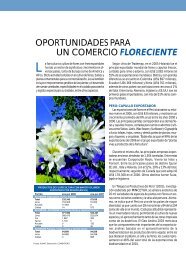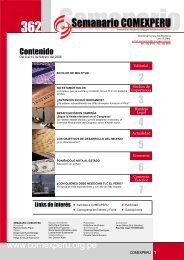Create successful ePaper yourself
Turn your PDF publications into a flip-book with our unique Google optimized e-Paper software.
PERÚ 2008<br />
24<br />
ESPECIAL APEC / APEC SPECIAL CuLTuRAL / CuLturAL<br />
“El Perú desde su literatura”<br />
Peru through its Literature<br />
A S<br />
partir de 1950 comienza a perfilarse en el Perú una<br />
nueva generación de escritores a los que, por colocar<br />
la ciudad en el centro de sus preocupaciones<br />
literarias, se les engloba dentro de una tendencia estética denominada<br />
“narrativa urbana”. Este último calificativo, como<br />
puede deducirse, alude también a otra narrativa previa que<br />
no era urbana y que tenía como escenario central la sociedad<br />
de los Andes.<br />
Ya se sabe que las obras literarias se basan en situaciones<br />
y personajes imaginarios; por eso hay que tomarlas como ficción.<br />
Sin embargo, buena parte de la ficción peruana de las<br />
últimas décadas ha reflejado de distinta forma el desarrollo<br />
social del Perú. Uno de los grandes dramas del país ha sido,<br />
desde sus viejos orígenes, la coexistencia de dos mundos y de<br />
dos culturas que solo en los últimos años han comenzado a<br />
fundirse y convertirse en una sola. El detonante de esta vasta<br />
transformación interna fueron las masivas migraciones de los<br />
Andes a las ciudades de la costa, en especial a Lima, a partir<br />
de los años 40 del siglo XX.<br />
Uno de los primeros relatos de esta nueva narrativa es “El<br />
niño de Junto al Cielo”, de Enrique Congrains (1932), que brilla<br />
en todas las antologías del cuento peruano por su estremecedora<br />
calidad estética y dramática; pero que también puede<br />
leerse como un retrato del momento en el que la ciudad de<br />
Lima, con apenas 500,000 habitantes, comienza a convertirse,<br />
por obra de estas oleadas migratorias, en la urbe de 8.5<br />
millones de habitantes de la actualidad.<br />
Francisco Tumi<br />
Escritor, periodista y catedrático universitario.<br />
Ha publicado la novela Las jerarquías de<br />
la noche.<br />
Writer, journalist and university professor. He has<br />
published the novel “Las jerarquías de la noche.”<br />
ince 1950, a new generation of writers started emerging<br />
in Peru placing the city in the center of their literary<br />
concerns. They are included within an esthetic tendency<br />
called “urban narrative”. As can be deduced, this defers<br />
to another, previous narrative which wasn’t urban and that<br />
had the Andes society as its center stage.<br />
It is well known that literary works are based on imaginary<br />
situations and characters - Same reason why we must take<br />
them as fiction. Nevertheless, in the last decades, a good portion<br />
of Peruvian fiction has reflected the social development<br />
of Peru in different manners. One of the biggest dramas in<br />
the country since its ancient origins is the co-existence of two<br />
worlds and two cultures that only in the last few years have<br />
begun to merge and become one. The trigger for this vast<br />
internal transformation was the massive migrations from the<br />
Andes to the cities in the coast, especially Lima, at the beginning<br />
of the 1940’s.<br />
One of the first tales of this new narrative is “El niño de<br />
Junto al cielo” by Enrique Congrains (1932), which shines in all<br />
Peruvian tales anthologies for its moving esthetic and drama.<br />
But it can also be read as a tale of the moment in which the<br />
city of Lima - with just 500,000 inhabitants - starts becoming<br />
the current city of 8.5 million due to the migratory waves.<br />
The new emerging writers from the 50’s compose stories<br />
that have this demographic and social transformation as a<br />
backdrop, and that in three generations’ time has changed the






